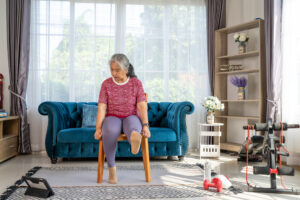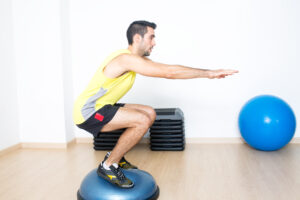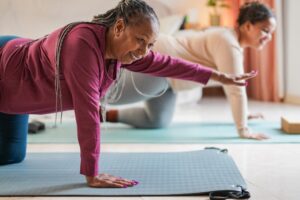Progressive Balance Training: A Friendly Step-by-Step Guide to Gradual Improvement
Progressive balance training is an essential approach to enhancing your stability and coordination. By gradually increasing the difficulty of exercises, you not only improve your balance but also boost your overall quality of life. This step-by-step guide will help you understand how to safely and effectively progress your balance training for lasting benefits.
Whether you’re an athlete looking to sharpen your skills or simply aiming to reduce the risk of falls, incorporating a structured balance program can make a significant difference. Each exercise plays a crucial role in developing the core strength and coordination necessary for improved balance. By following the right techniques, you can see real progress over time.
In this guide, you’ll discover various exercises, tools, and methods that cater to all skill levels. From assessing your current balance abilities to measuring your progress, you’ll find practical insights that will keep you motivated on your journey toward better stability.

Key Takeaways
- Progressive balance training can enhance your overall quality of life.
- A structured approach helps you gradually improve your stability and coordination.
- Monitoring your progress is essential for long-term success in balance training.
Understanding Balance and Its Importance
Balance is crucial for your everyday life. It helps you maintain stability and prevents falls, which can lead to serious injuries. Improving your balance can greatly enhance your quality of life, especially as you age.
Defining Balance and Stability
Balance refers to your ability to keep your body steady while standing or moving. It involves your muscles, joints, and nervous system working together. Stability, on the other hand, is how well you can maintain that balance under various conditions.
When you walk, run, or engage in any physical activity, maintaining balance allows for smoother movements. Good balance helps you feel more confident in your daily activities, whether you’re climbing stairs or navigating uneven surfaces.
The Relationship Between Age and Balance
As you age, your balance naturally declines. This can be due to several factors, including reduced muscle strength, joint problems, and changes in your sensory perception. Older adults may find it harder to react quickly when they start to lose balance.
Research shows that falls are a leading cause of injuries in older adults. Improving balance through exercises can significantly reduce this risk. It’s essential to address balance issues as they can affect not only your physical health but also your confidence and independence.
How Balance Training Benefits Daily Activities
Balance training offers many benefits that enhance your daily activities. By strengthening your core muscles and improving stability, you can perform everyday tasks with greater ease.
Some activities that greatly benefit from balance training include:
- Walking: Better balance means a more stable and comfortable walk.
- Climbing stairs: Improved balance makes navigating stairs easier and safer.
- Playing sports: Whether it’s tennis or yoga, balance helps you excel.
Incorporating balance exercises into your routine can improve your quality of life and allow you to enjoy activities with less fear of falling.
Fundamentals of Progressive Balance Training
Progressive balance training focuses on gradually improving your ability to maintain stability and coordination. Understanding the key principles can help you develop an effective training plan tailored to your needs.
Principles of Training Progression
Training progression involves gradually increasing the difficulty of your exercises. Start with simple movements, like standing on one leg, and slowly advance to more complex challenges.
You can use various strategies to progress your training:
- Increase the Duration: Hold a balance position for longer periods.
- Change the Surface: Move from a solid floor to a soft mat or balance pad.
- Add Movement: Incorporate arm or leg movements while balancing.
This gradual approach ensures your body adapts to new challenges, maximizing strength and coordination.

Setting Realistic Goals
Setting achievable goals is vital for your success in balance training. Break your larger goals into smaller, manageable steps.
For example:
- Short-term goals: Aim to balance on one leg for 10 seconds without support.
- Medium-term goals: Progress to balancing on a wobble board for 20 seconds.
- Long-term goals: Achieve balance while performing dynamic tasks, like reaching or turning.
Make sure your goals are specific and measurable. This way, you can track your progress and stay motivated throughout your journey.
Understanding the Overload Principle
The overload principle states that for your balance abilities to improve, you must challenge your body beyond its current capabilities. You can achieve this through resistance, duration, or complexity of movements.
Here are some ways to apply this principle:
- Increase Resistance: Use weights while doing balance exercises.
- Increase Complexity: Perform tasks with your eyes closed or on unstable surfaces.
- Vary the Environment: Try balancing while walking on uneven ground or during outdoor activities.
Incorporating overload will help your body adapt and improve your strength and balance over time.
Assessment and Planning
Before starting a balance training program, it’s important to understand your current abilities. This involves assessing your balance and creating a plan tailored specifically for you. Well-planned assessments and exercise programs help ensure safety and effectiveness as you improve your balance skills.
Conducting a Balance Assessment
Start by evaluating your current balance abilities. A simple way to do this is through a balance test. You can try the Single-Leg Stand Test. Stand on one leg for as long as possible without holding onto anything.
Alternatively, you could assess your balance through activities like walking heel-to-toe in a straight line. Keeping track of how long you maintain your balance or how well you perform these tasks can highlight areas needing improvement.
Consider consulting a healthcare provider or trainer to help with this assessment. They can provide insights into your unique needs and suggest appropriate exercises.
Creating a Customized Exercise Program
Once you have assessed your balance, the next step is creating a tailored exercise program. Focus on exercises that align with your abilities and goals.
Here are some effective exercises you might include:
- Balance exercises: Standing on one leg or using a balance board.
- Strength training: Working on your lower body can help improve stability.
- Flexibility routines: Stretching helps enhance range of motion, which can support better balance.
Aim for 30 minutes of physical activity most days of the week, dividing the time between balance, strength, and flexibility exercises. Make sure to gradually increase the difficulty as you progress.

Incorporating Personalized Care
Personalized care means adjusting your program based on your progress and any specific needs you may have. Regular follow-ups can help you stay on track.
Consider discussing your progress with a trainer or therapist. They can offer updates to your exercise program based on how you feel and your improvements.
Listen to your body throughout this process. If you notice pain or discomfort, adjust the exercises accordingly. Remember, your comfort and safety come first in any training program.
Types of Exercises for Balance Improvement
Improving your balance is a process that involves various types of exercises. These exercises can be divided into three main categories: static and dynamic balance exercises, strength training, and flexibility and mobility routines. Each category offers unique benefits to help you enhance your stability over time.
Static and Dynamic Balance Exercises
Static balance exercises help you maintain your center of gravity while standing still. A common example is the one-leg stand. To perform this, simply stand on one foot and hold the position for as long as possible. Aim for 30 seconds, then switch legs.
Dynamic balance exercises involve movement. Heel-to-toe walking is one great option. Walk in a straight line, placing the heel of one foot directly in front of the toes of the other. This exercise challenges your ability to stay upright while in motion.
Incorporate exercises like the single-leg cross-body punch to mix strength with balance. These exercises train your body to stabilize during movement.
Strength Training to Support Balance
Strength training is essential for better balance. Focus on exercises that target your legs, core, and glutes. Squats are an excellent choice; they strengthen your legs and core. To perform a squat, stand with feet shoulder-width apart, lower your body as if sitting in a chair, and then return to standing.
Another effective exercise is the lunges. Step forward with one leg, lowering your back knee toward the ground. This motion enhances your stability while strengthening your legs.
Additionally, exercises like the Paloff press with rotation help build core strength, which directly supports your balance when moving.
Flexibility and Mobility Routines
Flexibility plays a key role in balance. Stretching tight muscles improves your range of motion, making it easier to maintain stability. Consider routines that include hamstring stretches and hip openers.
Mobility exercises, such as the cat-cow stretch, not only improve flexibility but also enhance spinal movement. This helps your body respond better to changes in position.
Incorporating these flexibility and mobility routines into your exercise routine can lead to significant improvements in your overall balance.
Tools and Equipment
Using the right tools and equipment can make a big difference in your balance training. Various options are available to help you improve stability and strength effectively. Here’s a look at some of the most effective tools you can use.
Using Free Weights and Resistance Bands
Free weights, like dumbbells and kettlebells, are great for adding resistance to your balance exercises. They challenge your muscles while improving your stability. You can perform exercises like single-leg deadlifts while holding weights, which enhances balance as you lift.
Resistance bands are another useful tool. They provide adjustable tension that makes exercises like lateral band walks and single-leg squats more effective. Plus, they are portable and easy to use anywhere. Incorporating both free weights and bands will help strengthen your core and lower body, which are vital for balance.
Leveraging Bodyweight Exercises
Bodyweight exercises are incredibly effective for balance training. You don’t need any special equipment, making them accessible to everyone. Simple moves like squats, lunges, and single-leg raises can significantly improve your stability.
Try practicing standing on one leg while gradually increasing the time you hold the position. You can also do modified push-ups with your feet together for extra challenge. Bodyweight exercises focus on your core muscles, which play a critical role in maintaining balance throughout different activities.

The Role of Stability Balls and Balance Pads
Stability balls and balance pads add an extra layer of challenge to your training. Stability balls can be used for exercises like ball passes or wall squats. They require you to engage your core while maintaining balance.
Balance pads, on the other hand, are great for standing exercises. They create an unstable surface that forces your muscles to work harder to maintain stability. Standing on a balance pad during exercises like single-leg stands or squats can greatly enhance your balance training experience.
Techniques for Progressing Your Training
To make steady gains in your training, you can use specific techniques. These changes can help you increase your workout effectiveness. By adjusting frequency, intensity, and workout volume, you can avoid stagnation and improve your strength and balance.
Manipulating Frequency and Intensity
Adjusting the frequency and intensity of your workouts is key. Aim to train each muscle group at least two to three times per week. This frequency allows your muscles to adapt and grow stronger.
To change intensity, focus on how hard you push yourself. You can do this by increasing the weight you lift or by performing exercises with more speed. Use a weight that challenges you but allows you to maintain good form.
Tip: A good rule is to increase your weight by 5-10% once you can perform your target repetitions comfortably for two consecutive sessions.
Progression Through Reps and Sets
You can also progress by adding more reps and sets to your routine. Start with a manageable number of repetitions and gradually increase them over time.
For example, if you’re currently doing three sets of 10 reps, aim to increase to three sets of 12 reps. This small change can lead to big improvements in strength.
Keep track of your workouts in a journal or app. This will help you stay motivated and see your progress. Important: Always prioritize form to avoid injuries.
Overcoming Plateaus in Training
Plateaus can be frustrating, but they are a normal part of training. If you find you’re not making progress, it may be time to change your routine.
Consider altering your exercises or their order. Try new movements that still target the same muscle groups. You might also take a short break from lifting heavy and focus on balance or flexibility to refresh your body.
Another effective method is to incorporate drop sets. This technique involves reducing the weight after completing your set and continuing until you can’t do any more.
By mixing things up, you can break through those plateaus and continue to make gains.
Ensuring Proper Exercise Form and Technique
Maintaining proper form and technique during balance exercises is key to progressing safely and effectively. It helps you maximize benefits while reducing the risk of injury. Focusing on your posture, alignment, and movements can make a big difference.
The Importance of Proper Form
Using proper form while exercising ensures that you target the right muscles. For example, keeping your core engaged helps stabilize your body. This is essential for maintaining balance.
Good alignment also allows for more effective weight distribution, which reduces strain on your joints. It’s important to concentrate on your movements, especially in exercises like single-leg stands or balance boards.
Ensuring that your feet are hip-width apart can also provide a strong base. Follow these tips to enhance your balance training:
- Keep your back straight.
- Align your knees over your toes.
- Use your arms for balance as needed.
Avoiding Common Mistakes
Many people make small errors that can affect their performance. For instance, leaning too far forward or backward can throw you off balance. Always aim to keep a neutral spine and center your weight over your feet.
Another common mistake is rushing through the exercises. Take your time to focus on the movements. Quality is more important than speed.
Remember to avoid looking down at your feet. Instead, gaze ahead. This helps improve your balance and posture.
Try to get feedback from a trainer or use a mirror to check your form. Even small adjustments can lead to better results and reduced risk of injury.
Preventing Overuse Injuries while Progressive Balance Training
When you practice balance exercises, signs of overuse can occur if you push yourself too hard. Common symptoms include pain or discomfort in your joints. These injuries might develop slowly, making them easy to overlook.
To prevent overuse injuries:
- Start gradually and increase the difficulty of your exercises slowly.
- Incorporate rest days to give your body time to recover.
- Pay attention to your body’s signals. If something feels wrong, stop and reassess your technique.
Using a diverse range of exercises helps avoid strain on specific muscle groups. Consistency is important, but listen to your body and make adjustments as needed.
Special Considerations in Balance Training
Balance training is not a one-size-fits-all approach. It’s important to adapt exercises based on your needs. Different groups, such as seniors, athletes, and individuals in rehabilitation, require tailored strategies to maximize effectiveness.
Adapting Training for Seniors: progressive balance training
When designing balance training for seniors, safety is key. Start with simple exercises that can be done sitting or using support. For example, standing while holding onto a chair can help improve stability without risking falls.
Focus on enhancing strength in the legs and core. Exercises like chair stands or seated leg lifts can be beneficial. Incorporating visual and sensory cues also helps. For instance, using bright colors or objects to focus on can improve coordination.
Always encourage gradual progression. Seniors might start with basic skills and advance to more challenging exercises, such as single-leg stands or heel-to-toe walking.
Tailoring Exercises for Athletes toward Progressive Balance Training
Athletes have unique balance needs based on their sports. Training should emphasize sport-specific maneuvers. You can include activities like dynamic balance drills, which simulate movements that athletes frequently encounter.
Exercises such as lateral bounds or balance board training can improve stability during rapid movements. Strengthening the core is also crucial. A strong core supports better balance during athletic performance.
Additionally, it’s important to include agility training in balance programs. Using hurdles or agility ladders can enhance footwork and coordination, vital for athletic success.
Balance Training for Rehabilitation and Recovery
For those on a recovery journey, balance training often plays a key role. Tailor the intensity based on individual recovery stages. Start with low-impact exercises that focus on regaining strength and stability.
Incorporate activities such as gentle tai chi or water-based exercises to minimize strain. As progress is made, gradually introduce more challenging tasks, like balance exercises on unstable surfaces.
Pay attention to any pain or discomfort. Adjusting the training intensity and types of exercises is important for safe recovery. You can work with a physical therapist to ensure that exercises are appropriate for your specific rehabilitation needs.
Measuring Progress and Adjusting Your Routine
To get the best results from your progressive balance training, it’s essential to track your improvements and adjust your exercises as needed. This way, you can ensure that your routine remains effective and aligns with your goals.
Tracking Improvements in Balance and Mobility
Start by keeping a journal to record your daily balance and mobility exercises. Write down the types of exercises you do, the duration, and how you feel afterward. This can help you notice patterns and areas where you are improving.
For example, use a simple table to log your progress:
| Date | Exercise | Duration | Balance Rating (1-10) | Notes |
|---|---|---|---|---|
| 04/01/2025 | Single-leg stand | 30 sec | 7 | Steady, no wobble |
| 04/07/2025 | Tandem walking | 1 min | 8 | Felt more stable |
By reviewing this regularly, you can see how your balance is getting better. You might also want to use tools like stability trainers or balance boards to assess your skills more accurately.
When and How to Adjust Your Training Plan for Progressive Balance Training
Adjust your training program based on your recorded progress. If you find that certain exercises become too easy, consider increasing their difficulty. This could mean adding more time, trying a more challenging variation, or reducing support.
For instance, if you can easily hold a single-leg stand for one minute, try closing your eyes or standing on an unstable surface.
Remember to listen to your body. If you struggle with an exercise, it’s okay to repeat it until you feel ready to advance. Regularly reassess your goals every few weeks and make changes to your routine as needed for continued improvement.
Advanced Training and Long-Term Progression
As you advance in balance training, incorporating functional and sport-specific exercises can significantly enhance your performance. Additionally, exploring isotonic and isokinetic exercises can offer effective ways to build strength and stability.
Incorporating Functional and Sport-Specific Training
Functional training integrates movements that mimic everyday activities or sports. This type of training enhances your balance in practical situations.
For instance, exercises like single-leg squats or stability ball push-ups focus on core strength and balance. These exercises help improve proprioception, which is your body’s ability to sense its position in space.
If you’re into sports, consider sport-specific drills. For example, a soccer player can benefit from agility ladders that improve footwork and balance. Tailoring your training to your sport makes it more relevant and effective, ensuring your progress is not just theoretical but applicable.
Exploring Isotonic and Isokinetic Exercises help Progressive Balance Training
Isotonic exercises involve muscle contraction with movement, while isokinetic exercises use specialized equipment to maintain a constant speed. Both play a key role in balance training.
For isotonic exercises, try lunges or step-ups, which help improve strength in your legs and core, essential for maintaining balance. Aim for 10-15 repetitions to build endurance.
Isokinetic exercises often use machines that allow you to exert force at a controlled speed. These can be great for injury recovery and strengthening specific muscle groups. They assist in tracking your progress over time.
By integrating both types of exercises, you can create a balanced routine that supports gradual improvement and helps maintain your fitness levels long-term.
Frequently Asked Questions
Here are some common questions you might have about balance training. These will help you understand how to improve your balance and stability through various exercises.
What exercises can improve balance and stability at any age?
Exercises to improve balance include standing on one leg, heel-to-toe walks, and tai chi. You can also try yoga poses like tree pose and warrior III. These exercises are simple and can be adjusted to fit your skill level.
How often should balance exercises be incorporated into a workout routine?
It’s best to include balance exercises into your routine at least two to three times a week. You can start with shorter sessions and gradually increase the time as you get more comfortable with the movements.
Which balance exercises are most effective for at-home practice?
At-home balance exercises include single-leg stands, stable surface transfers, and gentle squats. Using household items like a chair for support can make these exercises easier and safer.
How do balance exercises enhance overall physical stability?
Balance exercises strengthen your core and leg muscles, which are key for stability. They also improve coordination and body awareness, helping you to react better to sudden movements or changes in terrain.
Can balance training also strengthen muscle groups? If so, which ones?
Yes, balance training can strengthen several muscle groups, including your core, legs, and even your back. Stronger muscles lead to better support for your body during daily activities and sports.
What are some dynamic balance exercises recommended by physiotherapists?
Dynamic balance exercises include side lunges, walking on uneven surfaces, and stability ball exercises. These activities challenge your body more and help improve your reaction time and balance in real-life situations.

